TechRadar Verdict
The AI behind Trint generates decent quality transcripts from clear recordings, and excellent editing and collaborative tools allow for efficient business workflows. We just wish they had a business plan for occasional users, alongside regular transcribers.
Pros
- +
Fast and easy to use
- +
Accurate transcriptions
- +
Free to try
- +
Translation included
Cons
- -
Aimed more at businesses
- -
Needs two-factor authentication
Why you can trust TechRadar
Accurate transcribing of audio by a person is a remarkably expensive and time-consuming exercise, where those that do perform it are often paid by the minute of the recordings they process.
Trint provides an AI-driven solution accessible via a web-page that can process audio recordings to create reasonably accurate transcriptions that can then be manually tweaked by the system to be perfect.
It’s squarely aimed at business users that need this functionality regularly, to transcribe meetings, interviews or negotiations.
Trint is patently a sophisticated tool with a hefty ongoing cost, but is it worth the expense?
- Want to try Trint? Check out the website here
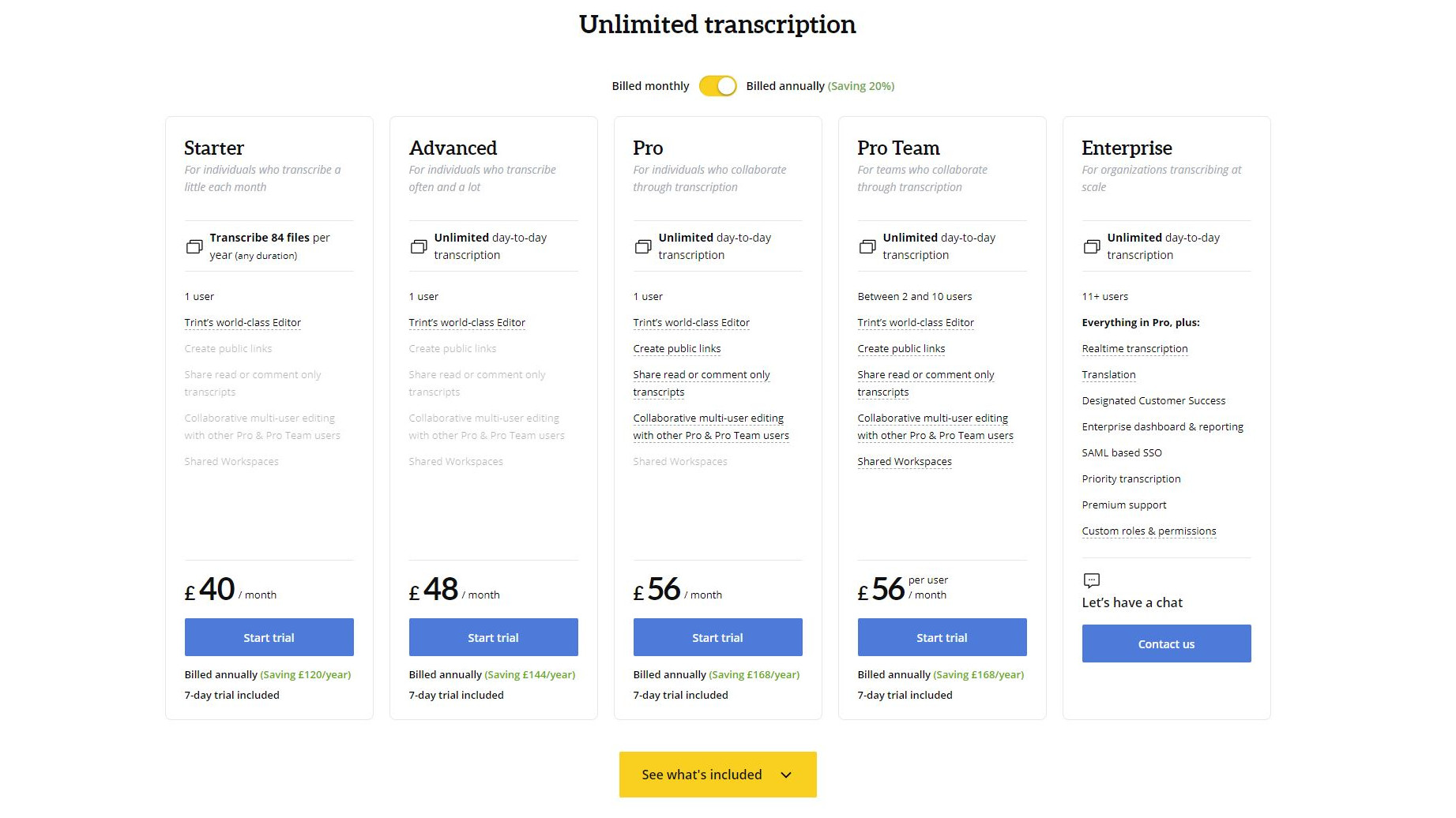
Costs of transcribing
Instead of taking the usual path of charging for the files transcribed based on their length, Trint offers five levels of subscription service. These range from single-user accounts with a capped number of files per year to plans that have unlimited use and enhance multi-user options.
The Starter plan costs £40 per month (billed annually) and allows for 84 files of any length to be transcribed for a single user, but just an extra £8 per month elevates this to the Advanced Plan that has ‘unlimited’ day-to-day use.
Strictly, this isn’t entirely unlimited, but more a fair-use version of that word. The level of use that archival projects, continuous live transcription and bulk exercises wouldn’t be considered applicable scenarios.
The Pro service adds sharing options and the ability to collaborate with other Pro and Pro Team account members for £56 per month. And, the same outlay per user adds team functionality in the Pro Team plan, for those businesses with between 2 and 10 users.
More users than ten users require an Enterprise plan that adds lots of management controls, priority transcription, SAML based SSO, and the price is dependent on the number of accounts required.
At first glance Trint is costly, but for a business that needs many recordings transcribed efficiently, the cost per recording processed could be relatively inexpensive.
But clearly, it’s not for anyone who needs an occasional transcription but for a business where this job is a requirement most days.
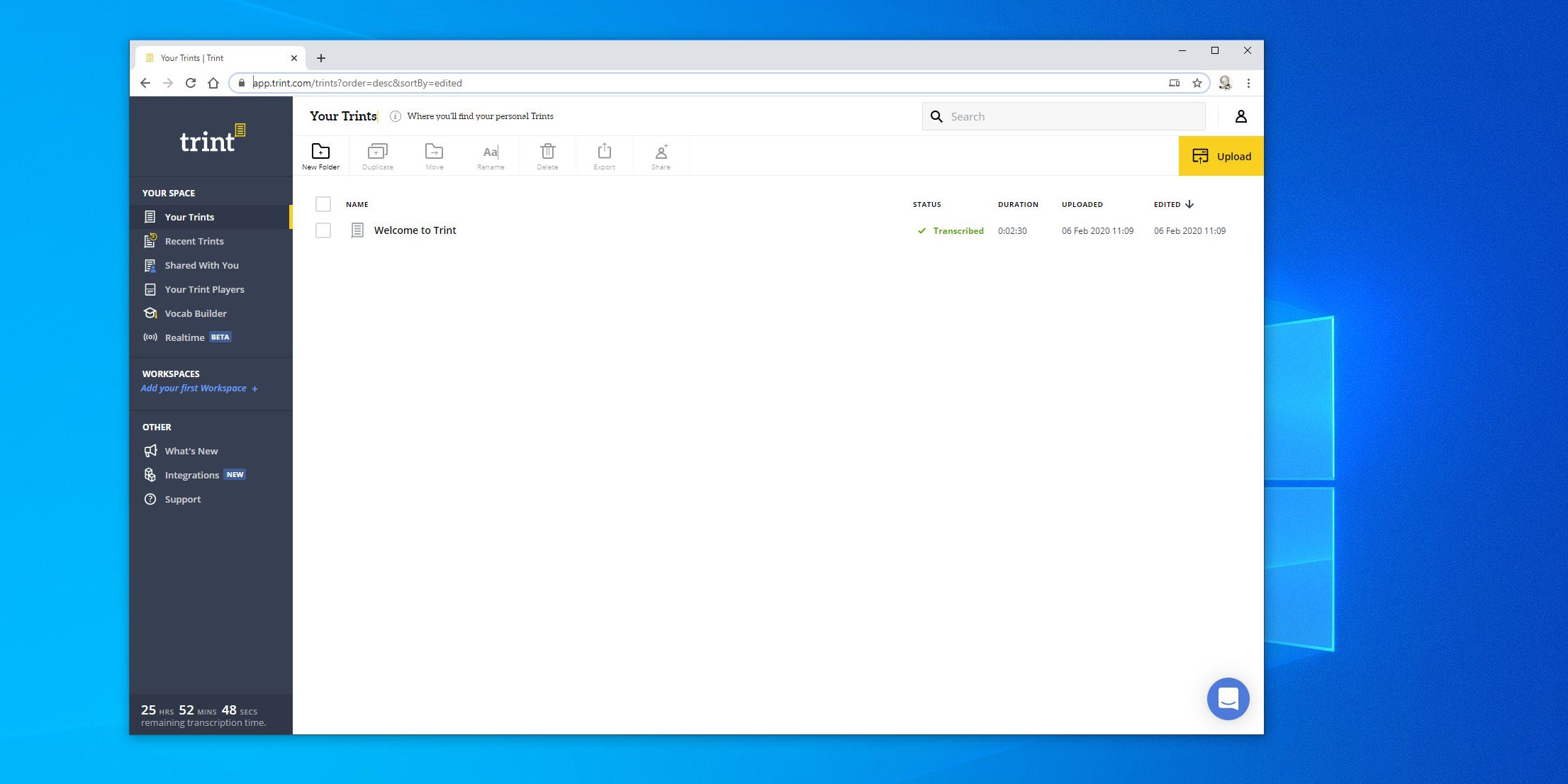
Design
The Trint interface is a masterclass in clear and focused presentation, where all the options are presented through a left-side menu, sub-functions are along the top and data is on the right.
Like many apps these days, the creators of Trint have a unique vocabulary that they share with the user, and refer to processed transcriptions as ‘Trints’. Therefore when you enter the application, you are shown your ‘Trints’ ready to review or edit.
From the same page, you can also upload new files for processing using a brightly coloured button.
Initially, most users will simply have audio recorded in MP3 or OGG, and then upload it from their computers. But, Trint can handle many file formats that include audio mixed with video, and Zapier links allow it to come from Google Drive, Box, Dropbox and many other online file storage facilities. It can even interface to Zoom video conferencing, for those that use that software to manage multi-site meetings.
Although this functionality is impressive, most enterprise customers will expect it, as they’re keen to connect their IT dots and deliver efficient workflows.
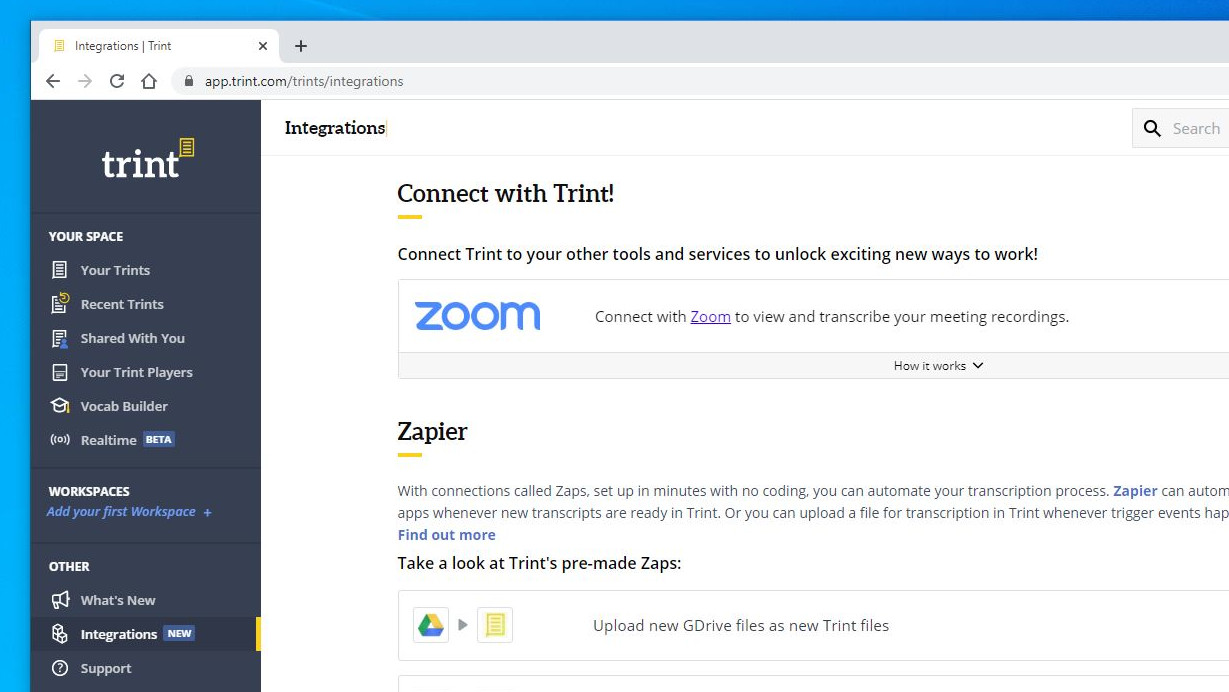
After the file has been uploaded, the user is asked to confirm the language, the workspace that the processed file will be sent. Since we last looked at Trint, the number of languages it supports has increased, and it also now supports different regional versions of some languages, like English. These enhancements enable the system to better process English spoken by those from the UK and America more accurately
For this review, Trint allowed us access to the Enterprise plan version of this solution, and it was impressively quick at transcribing our test content.
We estimated that it took between a third and a half of the recording time to process files, and by transcribing standards that’s quick.
But other systems can transcribe quickly and make a mess of it, how did Trint do?
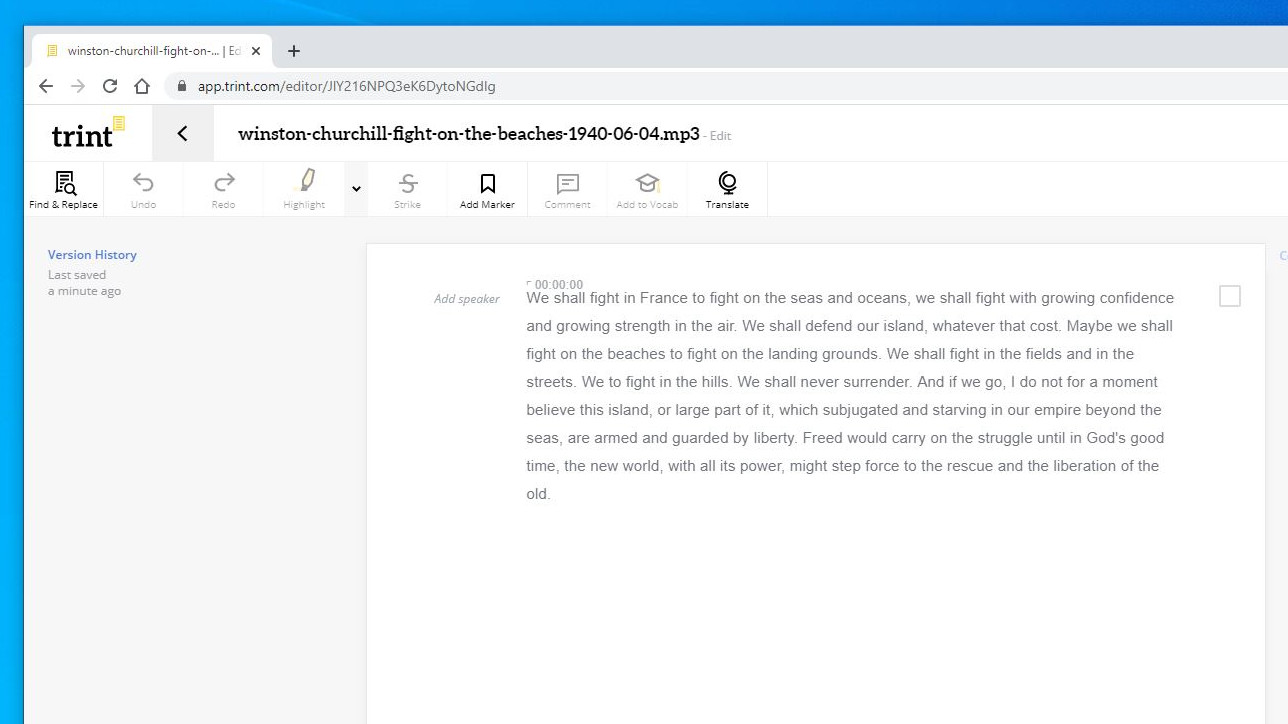
Post processing
After the audio has been processed the transcription and audio can be reviewed in parallel, allowing for manual adjustments. While you’re checking the transcription, you can also allocate sections to specific speakers if there are more than one.
Trint will try its best to identify different speakers automatically, but if replies are short (‘yes’, ‘no’, etc.) it might be required to label those.
If you notice a name or word that Trint repeatedly identifies incorrectly every time, it can be added the Vocabulary, enabling it to be correctly transcribed next time.
The functionality in this part of Trint is basic. But it provides the features that most users will require and one that we weren’t expecting.
That’s the ability to translate the Trint into another language, with a limited selection of choices available. This isn’t a feature that most users will need, but for those that need to relay transcriptions to parts of an international operation, it might be highly useful. Although, as we barely speak our native tongue with any finesse, we’re unable to attest how good a job it does in processing one language to another.
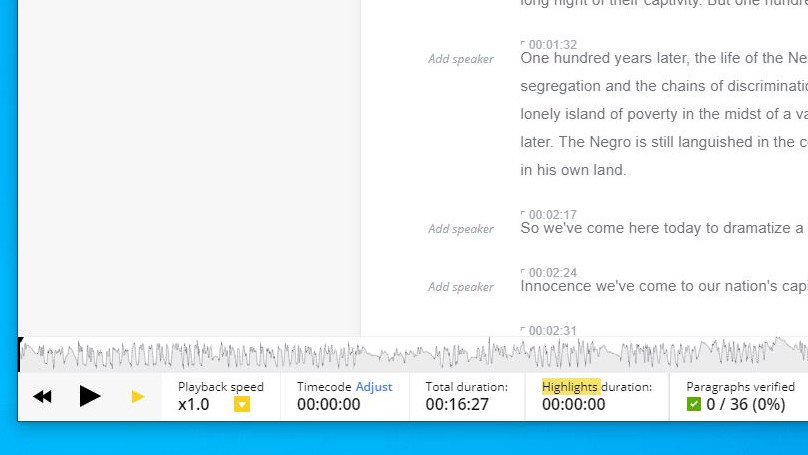
For those with a plan that supports multiple users, the transcription process can be shared with others. This option is ideal for long documents, as it enables checking and adjustment to be accomplished much more rapidly.
As a useful means to coordinate, it is possible to highlight sections and leave notes to others working with you.
The collaboration aspect of Trint is a strong point and one that could dramatically enhance its worth for those that have projects that can’t be effectively handled by a single user.
Export
The wide range of export formats demonstrates that Trint isn’t welded to any specific sector, but has file types that will be useful across many.
The obvious export choice is Word .docx, but it can also generate the subtitling format .srt, and several other structures that would be ideal for those working in video post-production.
A feature that should be very popular is the ability to post the combined file and transcription to a distributable URL. If you send this to a co-worker, for example, they can listen to the file (or watch the video) and read the transcript. As they don’t have an account, they won’t be able to edit the transcript but can email back any changes they’d like to those who have accounts.

Accuracy
We’ve yet to see a transcription product that admitted it was useless. Most claim to be amazingly accurate, even if that’s a dubious assertion in many instances.
But, in our tests, Trint is one of the better solutions we’ve seen, and except for names and technical words it was unfamiliar, it was generally accurate for cleanly recorded content.
It had more of an issue with old recordings where the quality wasn’t pristine, but even in those circumstances, it wasn’t bad.
We’re not sure this is the best solution to process an old archive of historical interviews, but it is certainly up to the task of transcribing meetings where sound quality can be better controlled.
Those with bulk conversion requirements should talk to Trint, as the standard plans aren’t meant for those that want to transcribe large video archives or live radio stations.
Security
Trint uses Amazon Web Services to hold the transcripts, and the specific servers are based in Virginia, USA.
The solution GDPR compliant, but at this time, Trint can’t offer HIPAA Certification.
All uploaded media content is kept for 30 days and then automatically deleted, transcripts are retained until the owner explicitly deletes them.
The pathway for user data to travel to the server is TLS 1.2+ protected, and once there it is encrypted using the tried and trusted AES-256 algorithm.
And, every action with a security implication is logged by the system for later review.
Each account is protected by a password that much be at least eight characters long and contain both cases and a number. And, changing it requires access to the email account of the user, where the reset link is sent.
Our only reservation about the password control is that ideally this software should have two-factor authentication, as Enterprise customers often make it a mandatory requirement of any software they use.
Hopefully, Trint will add this option soon.

Final verdict
The cost of Trint makes it only suitable for business users, but that doesn’t make it poor value for money.
No transcribing solution is perfect, not even human ones, but Trint is better than most we’ve tested. That equates to less polishing time, and more content transcribed.
And, even at these prices it massively undercuts the cost of manual transcription, where the monthly overhead for a single person on the Pro plan would be consumed by transcribing something of 20 minutes long or shorter.
- We've also highlighted the best transcription services
Mark is an expert on 3D printers, drones and phones. He also covers storage, including SSDs, NAS drives and portable hard drives. He started writing in 1986 and has contributed to MicroMart, PC Format, 3D World, among others.

